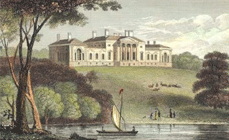Home > Famous Houses in england > Harewood house
Harewood House

Harewood House, located in West Yorkshire, England, is a magnificent country house renowned for its stunning architecture, extensive art collection, and picturesque landscape. Built in the 18th century, the house has been home to the Lascelles family, who became the Earls of Harewood, for generations. In this comprehensive overview, we will explore the history, architecture, art collection, and cultural significance of Harewood House.
History of Harewood House:
Harewood House was commissioned by Edwin Lascelles, 1st Baron Harewood, in the mid-18th century. The house was designed by the prominent architect John Carr and construction began in 1759. The construction process took several decades to complete, with various architects and designers contributing to its development. The house's interiors were created by renowned designers such as Robert Adam and Thomas Chippendale.
Architecture of Harewood House:
Harewood House is an exceptional example of Georgian architecture. The symmetrical façade features a central entrance flanked by grand wings, adorned with ornate columns and pediments. The house is built of honey-colored limestone, giving it a majestic and elegant appearance. The interior of Harewood House is equally impressive. The State Rooms, designed by Robert Adam, showcase exquisite plasterwork, elaborate ceilings, and opulent furnishings. The Gallery, in particular, is a highlight, displaying a remarkable collection of fine art.
Art Collection:
Harewood House is renowned for its extensive art collection, which spans several centuries and encompasses a diverse range of styles and genres. The collection includes works by renowned artists such as J.M.W. Turner, Thomas Gainsborough, and Joshua Reynolds. The Bird Room, specifically dedicated to the art of ornithology, houses a remarkable collection of bird paintings by Edward Lear. The room's elaborate bird-themed decorations create a unique and immersive environment. The Terrace Gallery hosts changing exhibitions, allowing visitors to experience a wide range of contemporary and modern art alongside the historical pieces. The house's art collection continues to grow through acquisitions and donations, ensuring its ongoing significance.
Cultural Significance of Harewood House:
I. Historical Significance: Harewood House holds a significant place in British history. It served as a backdrop for important events and gatherings, including visits from royalty and political figures. The house played a role in World War II when it was used as a military hospital, highlighting its versatility and adaptability to changing times.
II. Cultural Engagement and Education: Harewood House is open to the public and serves as an educational and cultural institution. The house offers guided tours, educational programs, and exhibitions that explore its history, art collection, and the broader social context of its time. Visitors can immerse themselves in the rich heritage of the house and gain a deeper understanding of British history, art, and architecture.
III. Landscape and Gardens: The house is set within a breathtaking landscape designed by Capability Brown, one of the foremost landscape architects of the 18th century. The gardens surrounding Harewood House feature beautifully manicured lawns, vibrant flower displays, and serene lakes. The landscape offers a tranquil retreat for visitors, providing a harmonious balance between the house and its natural surroundings.
IV. Community Engagement: Harewood House actively engages with the local community, hosting events, exhibitions, and educational programs. It collaborates with artists, performers, and cultural organizations to create a vibrant cultural hub, promoting artistic expression and community involvement.
V. Preservation and Conservation: Harewood House is dedicated to the preservation and conservation of its architectural and artistic heritage. The house undergoes regular maintenance and restoration projects to ensure its longevity. The estate also focuses on sustainable practices and environmental conservation, taking an active role in protecting its natural surroundings.
Conclusion:
Harewood House stands as a testament to the grandeur of Georgian architecture, showcasing an exceptional art collection and picturesque landscapes. Its rich history, cultural engagement, and commitment to preservation make it a cherished landmark in British heritage. Harewood House continues to captivate visitors with its timeless beauty, offering a glimpse into the past while embracing the cultural vitality of the present.









